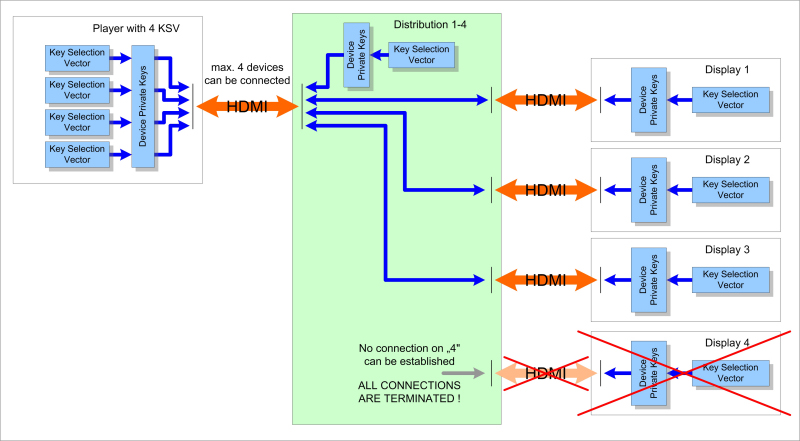
Example of one player with only four KSV and four displays via a 1-4 HDMI splitter - NO image on any of the four displays !
A player with at least five KSV is needed.
HDCP is a specification for protecting digital content that is transported via HDMI, DVI or DisplayPort interfaces. It was originally developed by Intel and the first HDCP 1.0 specification was released February 2000.
The digital content between the video source and the digital display is encrypted to protect the content of piracy. The content can only be seen on a projector or display that has also HDCP integrated ito the circuitry, not enabling the user to get the content out of the system for recording.
Even if the devices on either end of the application are HDCP compliant, all devices in between must be as well (repeaters, converters, switchers, splitter, distribution amplifiers, etc.).
HDCP implements authentication to verify that the receiving device (such as a display or television) is licensed to receive encrypted content. Re-authentication occurs approximately every two seconds to continuously confirm the security of the interface. In case the re-authentication does not occur the transmitting device ends transmission of the encrypted content.
HDCP is licensed by Digital Content Protection (LLC). LLC is a corporation formed to act as a holding company for the standard. Any implementation of HDCP requires a license obtainable from LLC.
Any HDCP licensed device has a set of unique and secret "Device Private Keys" implemented. A Key Selection Vector (KSV) is associated to these keys. The keys must be kept secret as a part of the license agreement. The set of Device Private Keys consists of 40 different 56-bit values.
By establishing a connection between two HDCP compliant devices, the Key Selection Vectors are exchanged and a combination of the Key Selection Vector and the Private Keys is used to create a unique code to encrypt and decrypt the content. With this method each time (each established connection between HDCP devices) a different unique code is used.
As part of the key management (KSV) for each device a maximum number of available keys is specified. HDCP allows up to 127 KSV for one device. Because one Key Selection Vector is needed to create a unique code for content transmission a player with 127 KSV could send encrypted material to up to 127 receivers (displays etc.).
Usual devices on the market have only a few KSV implemented (usually 2 to 16). A transmitting device with only two KSV that is be connected to a HDMI distribution unit could transmit signal to just one connected receiving display (one key is used for the distributor and one for the display). As soon as a second display would be connected, the signal transmission would be terminated completely!
The number of available keys for individual devices is normally not published be manufacturers. Crestron updates a list with devices and their available keys at: http://www.crestron.com/downloads/pdf/misc/third_party_hdcp_limits.pdf.

The FCC approved HDCP as a "Digital Output Protection Technology" in August 2004 and the FCC regulations require digital output protection technologies on all digital outputs for HDTV signals since July 2005.